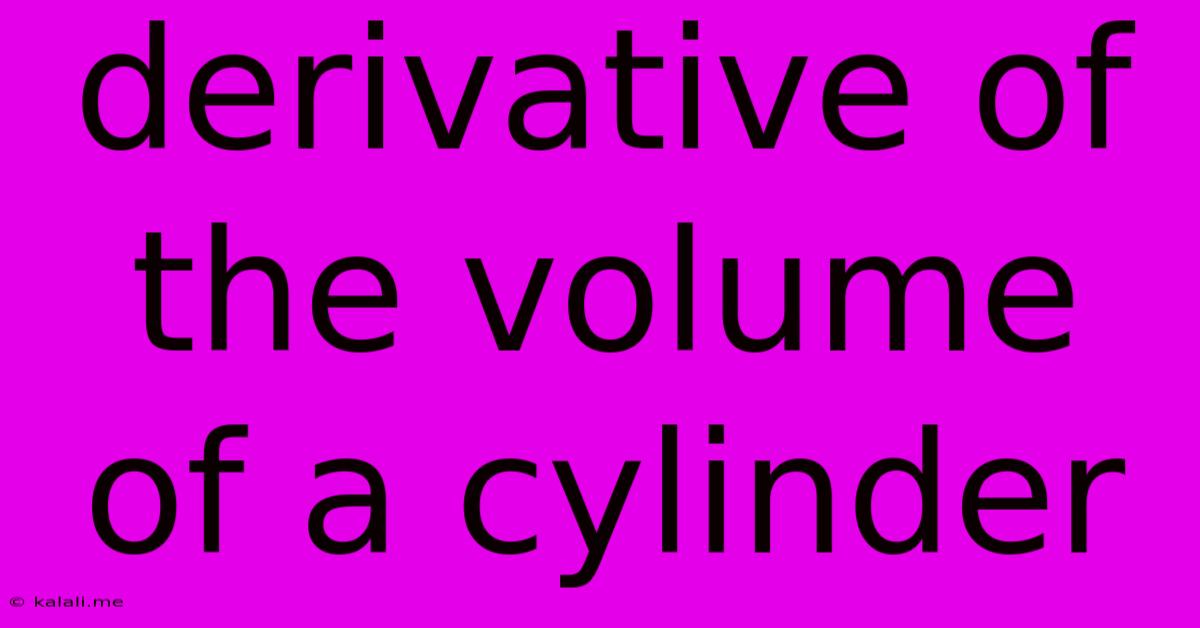Derivative Of The Volume Of A Cylinder
Kalali
Jun 15, 2025 · 3 min read

Table of Contents
Finding the Derivative of the Volume of a Cylinder: A Step-by-Step Guide
Understanding how to find the derivative of the volume of a cylinder is crucial in various fields, from calculus to engineering applications. This article provides a comprehensive guide to calculating this derivative, explaining the process step-by-step and exploring its practical significance. The meta description is: Learn how to calculate the derivative of the volume of a cylinder, a crucial concept in calculus and engineering. This step-by-step guide covers the process and its applications.
The volume of a cylinder is given by the formula:
V = πr²h
where:
- V represents the volume of the cylinder
- r represents the radius of the cylinder's base
- h represents the height of the cylinder
To find the derivative of the volume, we need to consider whether the radius, height, or both are changing with respect to time or another variable. Let's examine the scenarios:
1. Derivative with respect to radius (r), assuming height (h) is constant:
If the height remains constant while the radius changes, the derivative of the volume with respect to the radius is:
dV/dr = 2πrh
This tells us the rate at which the volume changes for a small change in the radius, keeping the height fixed. This is useful for understanding how a small increase or decrease in the radius impacts the overall volume. For example, in manufacturing, it allows for precision calculations for cylindrical objects.
2. Derivative with respect to height (h), assuming radius (r) is constant:
Conversely, if the radius remains constant and the height changes, the derivative of the volume with respect to the height is:
dV/dh = πr²
This derivative represents the rate of volume change concerning the height when the radius is unchanged. Similar to the previous scenario, this is valuable for understanding the effect of varying the height while maintaining a constant radius.
3. Derivative with respect to time (t), considering changes in both radius and height:
In a more dynamic scenario, both the radius and height might change over time. To find the derivative of the volume with respect to time, we apply the chain rule:
dV/dt = (∂V/∂r)(dr/dt) + (∂V/∂h)(dh/dt)
Substituting the partial derivatives we found earlier:
dV/dt = (2πrh)(dr/dt) + (πr²)(dh/dt)
This equation represents the rate of change of the cylinder's volume concerning time, considering the rates of change of both its radius and height. This application is frequently encountered in situations involving expanding or contracting cylinders, like inflating balloons or emptying tanks. This is particularly relevant in fields like fluid dynamics.
Applications and Real-World Examples:
Understanding the derivative of a cylinder's volume has numerous real-world applications:
- Engineering: Calculating the rate of change of volume in cylindrical tanks, pipes, or reservoirs is critical for designing and optimizing fluid systems.
- Manufacturing: Precision manufacturing of cylindrical components requires calculating the impact of even minor changes in dimensions on the final volume.
- Calculus and Physics: The concept is foundational for solving problems related to related rates, optimization problems, and understanding dynamic systems.
By understanding how to calculate these derivatives and interpreting the results, professionals can accurately model and predict the behavior of cylindrical systems across diverse fields. This helps with efficient resource management, precise manufacturing processes and accurate predictions in scientific fields.
In conclusion, calculating the derivative of the volume of a cylinder is a fundamental skill with widespread applications. The approach and results depend on which variable is changing – radius, height, or both simultaneously – leading to different formulas useful in various real-world scenarios. Understanding the appropriate formula and applying the chain rule when needed is key to solving problems involving cylindrical volumes and their dynamic changes.
Latest Posts
Latest Posts
-
What Is The Output Of The Following Code
Jun 15, 2025
-
A Word That Connects Words Phrases And Clauses
Jun 15, 2025
-
What Connects The Piston To The Crankshaft
Jun 15, 2025
-
Which Range Of Mountains Separates France From Spain
Jun 15, 2025
-
A Similarity Between E Commerce And Traditional Commerce Is That Both
Jun 15, 2025
Related Post
Thank you for visiting our website which covers about Derivative Of The Volume Of A Cylinder . We hope the information provided has been useful to you. Feel free to contact us if you have any questions or need further assistance. See you next time and don't miss to bookmark.